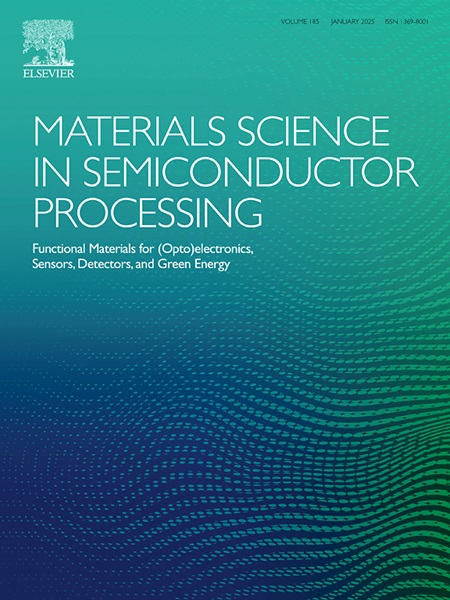Hydrothermally synthesized g-C3N4/InVO4 photocatalyst for effective potassium butyl xanthate pollutant degradation and photoelectrochemical analysis
IF 4.2
3区 工程技术
Q2 ENGINEERING, ELECTRICAL & ELECTRONIC
引用次数: 0
Abstract
In this investigation, graphitic carbon nitride g-C3N4 (gCN), Indium vanadate InVO4 (IV) and their compositional ratio nanocomposites (NCs) are fabricated by a facile one-step hydrothermal method for the estimation of degradation efficiency of potassium butyl xanthate (PBX) pollutant in mineral processing wastewater treatment under visible light irradiation. The g-C3N4/InVO4 (gCNIV) heterostructure was carefully engineered to exploit the synergistic interaction between g-C3N4's high chemical stability and InVO4's narrow bandgap (∼2.281 eV), forming an efficient type-II band alignment that promotes effective charge carrier separation and enhanced light absorption. Comprehensive characterization including XRD, SEM, XPS, and UV–Vis DRS confirmed the successful formation of the heterojunction and its optimized optical and structural properties. The optimized gCNIV-7.5 composite demonstrated exceptional photocatalytic performance, achieving 98.16 % degradation of PBX within 60 min, significantly outperforming individual components. Importantly, the composite exhibited high apparent quantum efficiency (AQE) of 33.42 %, underscoring its superior photon-to-chemical conversion capability. Stability tests, radical scavenging experiments, and photoelectrochemical analyses further verified the enhanced photocatalytic mechanism and durability of the gCNIV heterostructure. These findings establish gCNIV as a highly promising and efficient visible-light-driven photocatalyst for environmental remediation applications.
水热合成g-C3N4/InVO4光催化剂对丁基黄药钾污染物的有效降解及光电化学分析
本研究采用一步水热法制备了石墨化氮化碳g-C3N4 (gCN)、钒酸铟InVO4 (IV)及其组成比纳米复合材料(nc),用于在可见光照射下评价丁基黄药钾(PBX)污染物在选矿废水处理中的降解效率。g-C3N4/InVO4 (gCNIV)异质结构被精心设计,以利用g-C3N4的高化学稳定性和InVO4的窄带隙(~ 2.281 eV)之间的协同相互作用,形成有效的ii型带排列,促进有效的载流子分离和增强光吸收。XRD、SEM、XPS和UV-Vis DRS等综合表征证实了异质结的成功形成及其优化的光学和结构性能。优化后的gCNIV-7.5复合材料表现出优异的光催化性能,在60分钟内实现了98.16%的PBX降解,显著优于单个组分。重要的是,该复合材料的表观量子效率(AQE)高达33.42%,突出了其优越的光子-化学转换能力。稳定性测试、自由基清除实验和光电化学分析进一步验证了gCNIV异质结构增强的光催化机理和耐久性。这些发现表明gCNIV是一种非常有前途和高效的可见光驱动光催化剂,可用于环境修复。
本文章由计算机程序翻译,如有差异,请以英文原文为准。
求助全文
约1分钟内获得全文
求助全文
来源期刊

Materials Science in Semiconductor Processing
工程技术-材料科学:综合
CiteScore
8.00
自引率
4.90%
发文量
780
审稿时长
42 days
期刊介绍:
Materials Science in Semiconductor Processing provides a unique forum for the discussion of novel processing, applications and theoretical studies of functional materials and devices for (opto)electronics, sensors, detectors, biotechnology and green energy.
Each issue will aim to provide a snapshot of current insights, new achievements, breakthroughs and future trends in such diverse fields as microelectronics, energy conversion and storage, communications, biotechnology, (photo)catalysis, nano- and thin-film technology, hybrid and composite materials, chemical processing, vapor-phase deposition, device fabrication, and modelling, which are the backbone of advanced semiconductor processing and applications.
Coverage will include: advanced lithography for submicron devices; etching and related topics; ion implantation; damage evolution and related issues; plasma and thermal CVD; rapid thermal processing; advanced metallization and interconnect schemes; thin dielectric layers, oxidation; sol-gel processing; chemical bath and (electro)chemical deposition; compound semiconductor processing; new non-oxide materials and their applications; (macro)molecular and hybrid materials; molecular dynamics, ab-initio methods, Monte Carlo, etc.; new materials and processes for discrete and integrated circuits; magnetic materials and spintronics; heterostructures and quantum devices; engineering of the electrical and optical properties of semiconductors; crystal growth mechanisms; reliability, defect density, intrinsic impurities and defects.
 求助内容:
求助内容: 应助结果提醒方式:
应助结果提醒方式:


